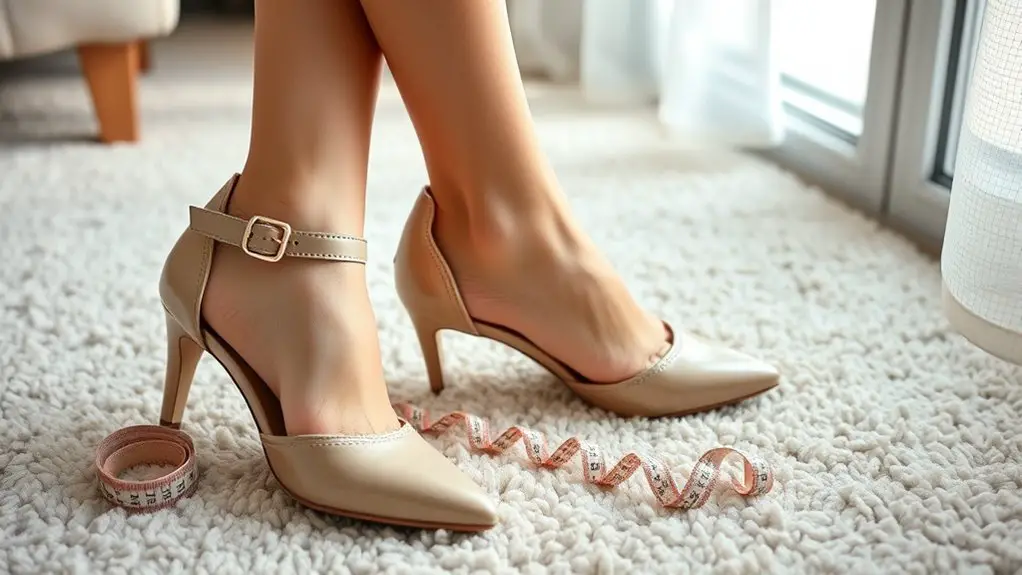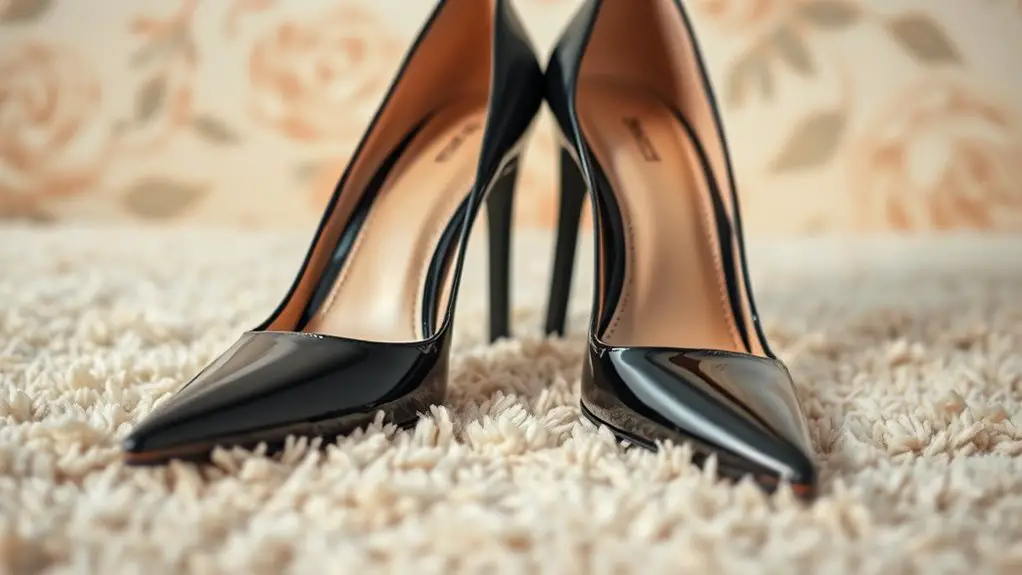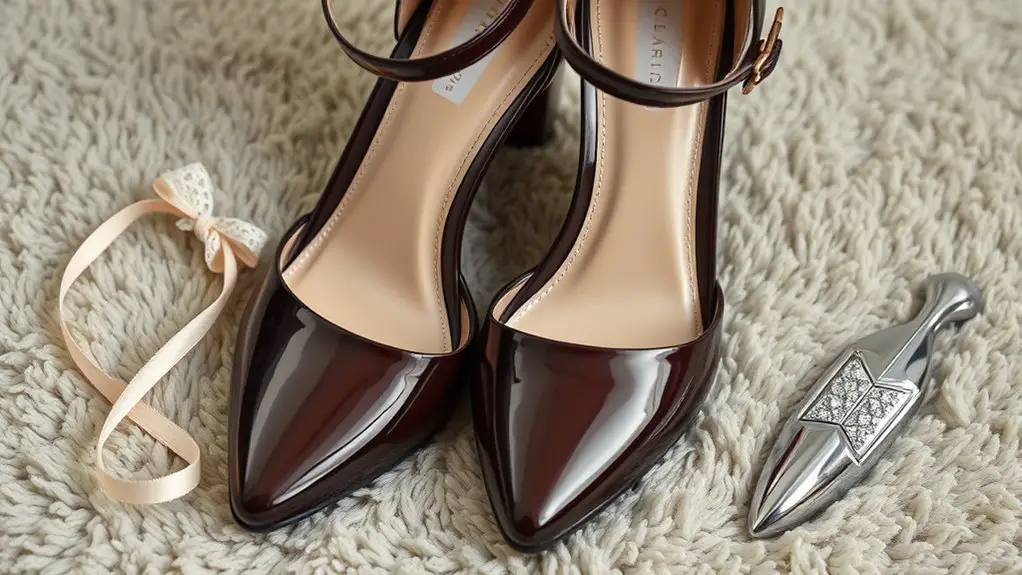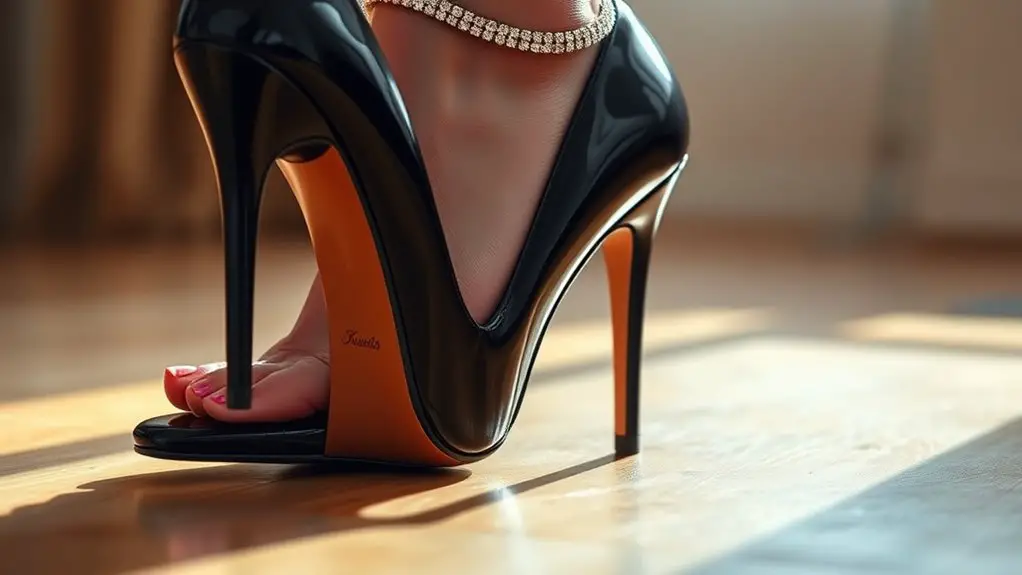To stop high heels from slipping off your feet, start by choosing the right size and fit; consult size charts as sizing varies. Opt for styles with stable ankle straps for added support. Use anti-slip insoles to enhance grip and consider heel grips for a snugger fit. Pay attention to the heel shape and materials that offer better traction. Finally, adjust your walking technique by taking smaller steps for improved control. There’s more to explore for a perfect fit.
Choose the Right Size and Fit

Choosing the right size and fit for your high heels is crucial to prevent them from slipping off. First, take accurate foot measurements, including the length and width of your feet. Use a ruler or a measuring tape to guarantee precision. Once you have your measurements, consult size charts from the specific brand you’re considering, as sizing can vary considerably across manufacturers.
When checking the size charts, pay attention to both the length and width categories. A size that fits well in length might not accommodate your foot’s width, leading to slippage. If you’re in between sizes, it’s often better to choose the larger size, as you can use insoles for a snugger fit. Always try on heels in the late afternoon when your feet are slightly swollen for a more accurate fit. This proactive approach can help you avoid discomfort and keep your heels securely on your feet.
Opt for Heels With Ankle Straps
Even with the right size and fit, high heels can still slip off if they lack proper support. Opting for heels with ankle straps can greatly enhance stability and prevent slipping. There are various ankle strap styles available, such as single straps, double straps, and wrap-around designs. Each style offers a different level of support, so choose one that best fits your comfort and aesthetic needs.
Additionally, consider the strap material. Leather straps tend to provide more durability and comfort, while synthetic materials can offer flexibility but may wear out faster. A well-constructed ankle strap can secure your foot in place, reducing the chance of slipping. When selecting heels, prioritize models with adjustable straps for a custom fit. By incorporating ankle straps into your footwear choices, you’ll gain confidence and stability, making your high heel experience much more enjoyable.
Use Anti-Slip Insoles

When high heels start to slip, one effective solution is to incorporate anti-slip insoles. These insoles are designed with advanced anti-slip materials that grip your foot securely, reducing the chances of slipping. You’ll want to choose insoles that offer adequate insole thickness to provide comfort while enhancing stability. Thicker insoles can absorb shock and distribute weight more evenly, making your heels feel less precarious.
When selecting anti-slip insoles, consider the material’s texture and grip level. Rubber and silicone are popular choices due to their excellent anti-slip properties. Verify that the insoles fit snugly within your heels without altering the shoe’s fit. This combination of anti-slip materials and appropriate insole thickness can greatly improve your comfort and confidence while wearing high heels. By making this simple adjustment, you’ll be able to stride with assurance, eliminating the worry of your heels slipping off your feet.
Try Heel Grips and Cushions
In addition to anti-slip insoles, heel grips and cushions offer another effective way to prevent your high heels from slipping off. These products enhance your shoe fit, providing stability and comfort. Here’s how you can benefit from them:
- Heel Grips: These adhesive pads fit inside the back of your shoe, creating friction that helps keep your heel in place. They’re especially useful for shoes that feel slightly loose.
- Cushion Pads: Placing cushion pads at the ball of your foot can relieve pressure and improve overall comfort, reducing the tendency for your foot to slide forward.
- Custom Fit: Many heel grips and cushion pads come in various thicknesses and materials, allowing you to choose the best option for your specific shoe type.
Consider Shape and Design

When choosing high heels, the shape of the heel can greatly affect how securely they fit your foot. A well-designed toe box is also essential, as it accommodates your toes without causing slippage. Additionally, consider strap options, which can enhance stability and keep your heels in place throughout the day.
Heel Shape Matters
Heel shape plays an essential role in how well high heels fit and stay on your feet. Understanding different heel styles can help you choose the right pair that aligns with your foot anatomy. Here are three key factors to take into account:
- Heel Height: Taller heels can cause your foot to slide forward, increasing the risk of slipping. Opt for a height that feels stable and comfortable.
- Heel Width: A wider heel offers more support and stability, reducing the chance of slipping compared to narrower styles.
- Heel Shape: Block heels or wedges distribute weight more evenly, enhancing grip and comfort, while stilettos may require more careful selection to confirm they fit snugly.
Choosing the right heel shape will keep your high heels securely on your feet.
Toe Box Design
The design of the toe box greatly impacts how well high heels fit and whether they’ll stay securely on your feet. A well-constructed toe box should balance width and shape to accommodate your foot comfortably. If the toe box width is too narrow, it can lead to discomfort and slipping, while a wider toe box can help keep your foot stable. Consider the toe box materials as well; materials like leather or suede provide better grip and stretch over time, adapting to your foot’s shape. When selecting high heels, verify the toe box design suits your foot’s anatomy, as this can considerably affect the overall fit and security, reducing the chances of slipping and enhancing your walking experience.
Strap Options Available
Choosing the right strap options can greatly enhance the fit and security of your high heels, especially after considering the impact of the toe box design. Understanding different strap types can help you find the perfect match for your needs. Here are three popular options:
- Ankle Straps: These provide added stability and can prevent slipping, ensuring your feet stay secure.
- Adjustable Straps: Allow you to customize the fit, catering to different foot shapes and sizes. This flexibility can considerably reduce discomfort.
- Cross-Straps: These not only add a stylish element but also distribute pressure evenly, enhancing comfort.
Select the Right Material
Selecting the right material for your high heels can make a notable difference in how well they stay on your feet. Different material types offer various levels of grip and comfort. For instance, leather provides a snug fit that molds to your foot over time, while suede adds texture options that enhance friction and reduce slipping.
If you prefer a synthetic option, materials like polyurethane can offer flexibility and breathability but may not grip as well as natural fibers. Additionally, consider the heel’s surface; rubberized soles can improve traction, helping your shoes stay securely in place.
When choosing high heels, pay attention to the inner lining as well. Materials like microfiber can create a non-slip surface against your skin. By selecting the right combination of materials, you can notably minimize the chance of your heels slipping off, ensuring comfort and stability throughout your day.
Adjust Your Walking Technique
While you might not think about it, adjusting your walking technique can greatly impact how well high heels stay on your feet. Proper walking posture and foot placement are essential for maintaining stability and preventing slips. Here are three tips to help you walk confidently in heels:
Adjusting your walking technique can significantly improve how well high heels fit and stay secure on your feet.
- Stand Tall: Keep your shoulders back and your head up. Good posture not only enhances your appearance but also improves balance, making it easier to keep your heels on.
- Place Your Feet: Focus on landing your foot directly underneath your body. This helps distribute your weight evenly and reduces the chance of your heels slipping off.
- Take Smaller Steps: Shorter strides allow for better control and less strain on your ankles. This makes it easier to navigate different surfaces without wobbling or losing your footing.
Maintain Your Heels
To guarantee your high heels remain secure and comfortable, regular maintenance is essential. Start with proper cleaning; dirt and grime can cause your heels to wear unevenly, leading to instability. Use a soft cloth and a mild soap solution to wipe down the exterior, focusing on scuffs and stains.
Another critical aspect of heel maintenance is inspecting the insoles. Over time, they can lose their grip and cushioning. If they appear worn, consider replacing them with high-quality inserts designed for heel support.
Additionally, check the heel tips regularly. Worn-down tips can destabilize your footing, so replace them promptly to assure a secure fit.
Finally, store your heels properly. Use shoe trees or keep them in their original boxes to maintain their shape. By following these heel maintenance tips, you’ll enhance comfort and longevity, reducing the chances of slipping.
Explore Custom Solutions
If you find that store-bought solutions aren’t cutting it, exploring custom options can greatly enhance your comfort and stability in high heels. Custom fitting offers a tailored approach to addressing your unique foot shape, ensuring a snug fit that reduces slippage. Here are a few personalized solutions to weigh:
Exploring custom fitting for high heels can significantly improve comfort and stability, ensuring a snug fit tailored to your foot shape.
- Personalized Inserts: Custom-made inserts can be designed to fill any gaps and provide extra cushioning, reducing the chances of your heels slipping off.
- Heel Grips: These can be specially molded to your heels, preventing movement and enhancing grip.
- Professional Adjustment: A cobbler can adjust the fit of your heels by modifying the structure, creating a more secure fit.
Frequently Asked Questions
Can I Wear High Heels if I Have Wide Feet?
Wearing high heels with wide feet isn’t impossible. You’ll need to explore wide feet solutions and prioritize heel comfort tips, ensuring your shoes fit snugly while allowing your feet to breathe and move freely.
How Do I Clean My Anti-Slip Insoles?
To clean your anti-slip insoles, use mild soap and water, ensuring you know the insole materials. Avoid harsh chemicals, and air dry them completely. Regular cleaning methods will maintain their effectiveness and longevity.
Are There Specific Brands Known for Better Heel Fit?
Brands boast better heel fit, particularly those specializing in stylish support. Look for brand recommendations like Jimmy Choo or Stuart Weitzman, known for their diverse heel styles that combine comfort and elegance effectively.
What Should I Do if My Heels Still Slip After Adjustments?
If your heels still slip after adjustments, consider using heel grips or inserts for better heel fitting. Additionally, shoe accessories like anti-slip pads can enhance stability and prevent slipping, ensuring a more secure fit overall.
Can Wearing High Heels Cause Long-Term Foot Problems?
Yes, wearing high heels can lead to long-term foot problems, including heel discomfort and altered foot health. It’s essential to choose supportive footwear and limit high heel usage to mitigate these potential issues over time.



